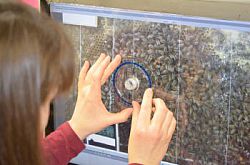‘Listen to the bees’ to create healthy rural landscapes, says Sussex study
Honey bees’ foraging preferences can provide valuable information for governments about how to better manage rural landscapes, say University of Sussex researchers.
 Which direction? Bees' waggle dancing reveals rich feeding areas
Which direction? Bees' waggle dancing reveals rich feeding areas
In the past two decades, the European Union has spent €41 billion on Agri-Environment Schemes (AES), which aim to improve the rural landscape health by implementing changes, such as the creation of areas for wildlife around crop fields.
There are different levels of AES, although few studies exist evaluating how wildlife responds to the schemes.
New research published this week (22 May) in the journal Current Biology reveals that, through their ‘waggle dance’, honey bees identify the areas of rich sources of pollen and nectar as being in rural lands under Higher level AES rather than any other land type, including urban areas and rural lands not under AES.
Researchers at Sussex’s Laboratory of Apiculture and Social Insects (LASI) spent two years filming waggle dances made by worker honey bees living in glass-fronted observation hives. They then decoded the dances to discover where bees were gathering their food.
Lead researcher Dr Margaret Couvillon says: “Usually efforts to help wildlife take two approaches. One is to set aside important areas like National Parks or National Nature Reserves. Another approach is to make existing areas more wildlife-friendly, like the Agri-Environment Schemes.
“Here we have let the bees tell us which practices and what areas are good for them. The honey bee is acting as an ‘indicator’ species pointing to ‘healthy landscapes’. Because the honey bee is a generalist forager, landscapes used by honey bees are good for a wide range of pollinators.
“The waggle dance is, therefore, more than just a honey bee behaviour. It is a powerful tool for ecology and conservation, providing unique information that may help to evaluate landscapes and human efforts to sustain a more wildlife-friendly world.”
The waggle dance is a unique behaviour found only in honey bees. A bee collecting from a profitable patch of flowers will dance upon returning to the hive to tell her nestmates where this good food is located. The dance (in which the bee waggles its abdomen while moving in a figure of eight pattern) gives the direction and distance from the hive to the patch.
By combining the waggle dance data with maps of land use the researchers could make a landscape-wide survey of the surrounding 94 km2. Such a huge area was possible because honey bees forage at long distances (many km) from their hives.
The bees were able to access the surrounding countryside and the nearby city of Brighton and Hove via tubes through the lab wall that opened to the outside. This landscape was divided into one of sven land types (urban, rural, and five types of rural under government-funded AESs).
The study showed that the most plentiful areas for foraging were rural lands in Higher Level Stewardship and Castle Hill National Nature Reserve, which is also managed under High Level AES. Castle Hill is a fine example of ancient, wildflower-rich, chalk grassland sites and is also noted for being a good place for butterflies.
Professor Francis Ratnieks, who supervised the study, says: “The honey bee dance language was one of the most unexpected scientific discoveries of the 20th century. In 1973 the discoverer, Austrian scientist Karl von Frisch, was awarded a Nobel Prize for the discovery. It’s good to be following in his footsteps, and to use this amazing behaviour to help bees.
“In this project we did something that could not be done with any other animal. We eavesdropped on the honey bee’s own communication system to find out where they gather food.”
